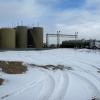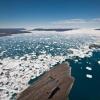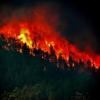Climate & Environment
- <p>A new University of Colorado Boulder framework used to screen hundreds of organic chemical compounds used in hydraulic fracturing, or fracking, shows that 15 may be of concern as groundwater contaminants based on their toxicity, mobility, persistence and frequency of use.</p>
 <p>A dramatic increase in the rate of earthquakes in the central and eastern U.S. since 2009 is associated with fluid injection wells used in oil and gas development, says a new study by the University of Colorado Boulder and the U.S. Geological Survey.</p>
<p>A dramatic increase in the rate of earthquakes in the central and eastern U.S. since 2009 is associated with fluid injection wells used in oil and gas development, says a new study by the University of Colorado Boulder and the U.S. Geological Survey.</p> <p>A tougher federal standard for ozone pollution, under consideration to improve public health, would ramp up the importance of scientific measurements and models, according to a new commentary published in the June 5 edition of <em>Science</em> by researchers at NOAA and its cooperative institute at the University of Colorado Boulder.</p>
<p>A tougher federal standard for ozone pollution, under consideration to improve public health, would ramp up the importance of scientific measurements and models, according to a new commentary published in the June 5 edition of <em>Science</em> by researchers at NOAA and its cooperative institute at the University of Colorado Boulder.</p> <p>In northwestern Greenland, glaciers flow from the main ice sheet to the ocean in see-sawing seasonal patterns. The ice generally flows faster in the summer than in the winter, and the ends of glaciers, jutting into the ocean, also advance and retreat with the seasons.</p>
<p>In northwestern Greenland, glaciers flow from the main ice sheet to the ocean in see-sawing seasonal patterns. The ice generally flows faster in the summer than in the winter, and the ends of glaciers, jutting into the ocean, also advance and retreat with the seasons.</p>- <p>In a state known for its dramatic weather and climate, Colorado’s history of extreme precipitation varies considerably by season and location, according to a new study led by the Cooperative Institute for Research in Environmental Science, a partnership between the University of Colorado Boulder and NOAA.</p>
- <p>A University of Colorado Boulder and North Carolina State University-led team has produced the first atlas of airborne microbes across the continental U.S., a feat that has implications for better understanding health and disease in humans, animals and crops.</p>
- <p>A new material developed at the University of Colorado Boulder could radically reduce the energy needed to produce a wide variety of plastic products, from grocery bags and cling wrap to replacement hips and bulletproof vests.</p>
- <p>A team of scientific investigators is now in the Four Corners region of the U.S. Southwest, aiming to uncover reasons for a mysterious methane hotspot detected from space by a European satellite. The joint project is working to solve the mystery from the air, on the ground, and with mobile laboratories. </p>
 <p>Western U.S. forests killed by the mountain pine beetle epidemic are no more at risk to burn than healthy Western forests, according to new findings by the University of Colorado Boulder that fly in the face of both public perception and policy.</p>
<p>Western U.S. forests killed by the mountain pine beetle epidemic are no more at risk to burn than healthy Western forests, according to new findings by the University of Colorado Boulder that fly in the face of both public perception and policy.</p>- <p><span>Seventy percent of forested lands remaining in the world are within a half mile of the forest edge, where encroaching urban, suburban or agricultural influences can cause any number of harmful effects, according to a new study involving </span><span>CU-Boulder </span><span>scientists.</span></p>


